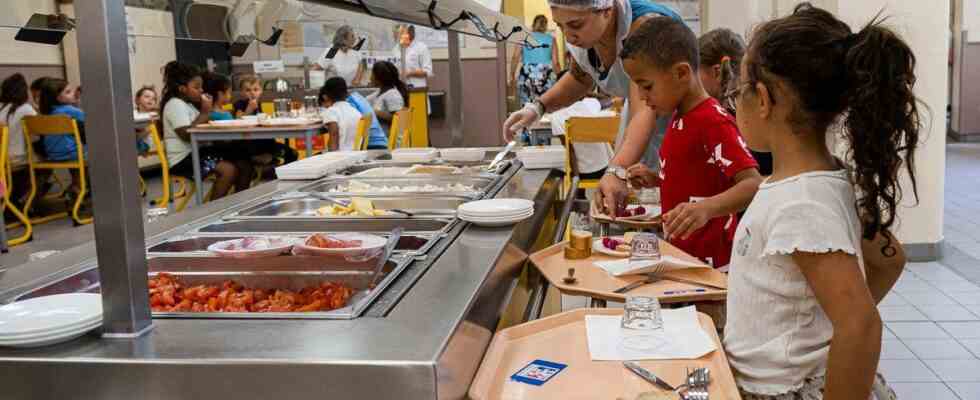In this new school year, communities have found themselves faced with a puzzle: how to absorb the increase in the price of meals in the canteen? In one year, the prices of raw materials have increased by 12%, recalls the national union of collective catering. Those of food have followed a vertiginous curve: +30% for poultry, +25% for beef, +70% for oil which has become a rare commodity. Not to mention the drought that is ravaging the country and which could raise fears of a shortage in the coming months. Result: the prices of meals in the canteen have risen by 10% on average, estimates the AMF, association of mayors of France. And for municipalities, cities, metropolises or departments, the bill begins to be salty.
“To the price of meals, we must add the increase in energy prices and that of the index point in the public service which affects canteen staff, raises Gilles Pérole, member of the AMF and deputy mayor of Mouans-Sartoux (Alpes-Maritimes). It is also necessary to take into account the revenues of the communities which are at half mast. Clearly, the equation becomes complicated to balance the budget. »
The cities of Paris, Lyon, Toulouse, Bordeaux are all responsible for
Most of the big cities, which are strong enough to absorb the costs, have decided to take care of everything. This is the case in Lyon, where 26,000 meals are served daily. The municipality had been working for eighteen months on its new school catering offer: 50% organic and 50% food from local producers. Meals, which families pay between 80 euro cents and 7.30 euros, now cost 13 euros. The effort is far from negligible. “This represents an additional cost of 4 million euros compared to last year, indicates Stéphanie Léger, assistant in charge of Education. But we have made the political choice to assume it fully this year. »
In Paris, where 23 million meals are distributed per year, prices will not increase either. Despite inflation, the City has “specifically instructed” the Caisses des Ecoles, which provide school catering, to “not reduce the quantity or quality” of the plates served. For this, it has undertaken to increase the subsidy granted to them each year.
Review your menus
Throughout France, trade-offs had to be made to absorb the costs as much as possible. In Bordeaux, for example, the municipality has reviewed the content of its dishes. “We put more vegetarian components in our menus,” says Delphine Jamet, assistant in charge of general administration. Inflation is less important for legumes than for meat. We should feel it in a while. Given the soaring prices of conventional flour, the city has opted for organic bread, which is much cheaper to manufacture. She also ditched sunflower oil in favor of olive oil. “What saves us is having established public markets with local producers, in organic, analyzes the elected official. As it is a less mechanized agriculture, with fewer chemical inputs, the costs have increased less. This greatly reinforces our approach to relocate production and consumption. »
In Toulouse, we are betting on raising awareness among staff and students about food waste. “This is a strong lever for savings”, emphasizes Marion Lalane de Laubadère, Deputy in charge of Education. The commune of Mouans-Sartoux has already reduced food waste by 80% in ten years. “Of course, we could not play on this card, raises Gilles Pérole. So we looked for solutions elsewhere. » Like reducing meat consumption and using raw products rather than processed ones. “We introduce more vegetable proteins or eggs in the menus, summarizes the elected official. We had already committed to having half of the meals vegetarian. This only accelerated the end goal. Yet that was not enough. Unable to assume the additional costs in their entirety, the municipality decided to “cut the pear in half”. “The cost of meals has increased by 20 cents. Half is paid for by the families, the other half by the town hall”, indicates Gilles Pérole.
To find your way around, the town of Caudebec-lès-Elbeuf (Seine-Maritime) which lists 4,000 souls, has made more drastic choices. Menus now consist of only four items. Depending on the day, the children do without a starter or cheese. This saves parents from paying more.
“More generic menus”
In Limoges, the municipality tries “to have a more flexible management” of school catering by offering “more generic menus”. “We indicate the main course and for the rest, we are more vague. Instead of announcing strawberry yoghurts, dairy products are announced, explains Vincent Julby, first deputy in charge of educational policy. This allows us to benefit from promotions on certain products, cheaper, or local products, in short circuit, organic, which are often unforeseen and which we can thus access more quickly. Despite this, the town hall has resolved to reassess its rates. “Canteen prices had not changed since 2013. Despite the pandemic, during which many families found themselves unemployed or without activity, we did not raise prices so as not to add a constraint to them, explains Vincent Julby . But there, the costs have really increased. The bill sent to parents now amounts to 27 cents more per meal. The price to pay for not reducing the quantity on the plates or “restricting certain products”. The social tariff, 1 euro, which the municipalities of less than 10,000 inhabitants finance alone, is maintained.
If most communities have found a plan B for this start of the school year, what will happen next year? “We expect an increase of between 22 and 35% in 2023, against 12.5% today,” predicts Delphine Jamet. In Lyon, the questions are the same. “We do not yet know how the city will be able to assume the rest. We do not know if our service provider, who is responsible for buying from producers, will increase his prices, confesses Stéphanie Léger. However, there are still margins on which to negotiate…”

